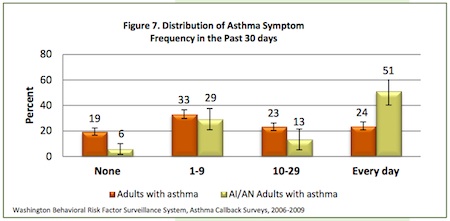 |
| BE PART OF THE PROCESS: IMPROVING ASTHMA OUTCOMES IN TRIBAL COMMUNITIES |
Did you know that 51% of American Indian/Alaska Native adults with asthma experience symptoms every day in Washington State? The graph below from a Washington State Department of Health report makes the burden of asthma in tribal communities very clear.

All of us working as professionals in housing departments, air and environment programs, and health clinics have a role to play in improving asthma outcomes. No single initiative or new treatment is the answer - it's the process and perspective of continual improvement that will keep us moving in the right direction. Questions like these are the building blocks of long-term impacts on asthma:
- How can my department provide better asthma services?
- How can I strengthen bridges between school nurses and health care providers?
- How can my organization reduce exposures to household air pollutants that may cause asthma?
What questions will get your work addressing asthma going?
One exciting example is an initiative that would allow Medicaid funds to pay for asthma home visits, which means your tribe would be able to pay someone to look for environmental asthma triggers in a patient’s home. This month, tribal health care, housing and environmental leaders will be meeting in Seattle on this topic. If your tribe is in Washington State, we invite you to join us for a similar asthma summit on November 14 in Tumwater, WA. The afternoon tribal track will build on the Seattle summit, with the goal of making reimbursement possible for Washington tribes.
Statistics tell a story. This is a photo of TJ, a Tulalip grass dancer. As a young child TJ spent time in the hospital due to asthma. Many tribal parents like TJ's mother experience the burden of asthma with frequent need for urgent care. In a study in Washington State, native infants were hospitalized for asthma at more than twice the rate of the general population.
|
 |
| WHAT CAN YOUR DEPARTMENT DO TO IMPROVE ASTHMA OUTCOMES? |
HEALTH CLINIC: Does your health clinic use a pediatric environmental history form?
This
form can help gather information on commonly overlooked asthma triggers in a child's home, school, and other indoor environments. Using this tool allows health care professionals and families to make connections between environment and asthma, and take steps to reduce those triggers.
AIR & ENVIRONMENT PROGRAMS: Do your home assessments help reduce the cost of asthma care?
The answer is yes, they can! The American Lung Association in Minnesota evaluated their home assessment program targeted at limited income children with asthma and their families, and found that for every $1.00 spent on the home visitor and allergen-reducing products provided to the homes, a savings of $1.76 was reported in asthma related total health care costs. This adds up to improved quality of life and
money saved for those patients and their families. Read more here.
HOUSING: Does your housing department use asthma-friendly construction pratices?
The National Center for Healthy Housing report, "A New Prescription for Asthma Sufferers: Healthier Homes", highlights key building materials that really make an impact on reducing asthma. Here are a few of the breathe easy specifics:
- Positive whole house ventilation systems: Removes stale air, filters incoming air and reduces moisture
- Linoleum flooring in living areas and bedrooms, recycled content vinyl flooring in bathrooms and kitchens, low-pile carpeting in stair and halls to reduce allergens
- Low/no off-gas trim and mill work to reduce urea formaldehyde bonding agents
- Low/no off-gas or volatile organic compounds (VOCs) cabinet construction
- HEPA filter vacuums to remove allergens
- Walk-off doormats to reduce dirt in the homes
- Special attention to protect building materials from moisture during construction
|
 |
| NOTEWORTHY ASTHMA EFFORTS IN A TRIBAL PROGRAM: A SWINOMISH PROFILE |
|
Tony Basabe, Air Quality Analyst, Swinomish Indian Tribal Community talks about what a health-based tribal air program can look like.
 "I look at asthma trends in our community and use that data as one way to monitor indoor air quality. If I see that there is an uptick in asthma rates, then I start looking around for clues as to what the causes may be. We partner with our health clinic to get this data, which has been important to support our work." ...Read more here "I look at asthma trends in our community and use that data as one way to monitor indoor air quality. If I see that there is an uptick in asthma rates, then I start looking around for clues as to what the causes may be. We partner with our health clinic to get this data, which has been important to support our work." ...Read more here
|
 |
| NOTEWORTHY ASTHMA STRATEGIES FROM OUR PARTNERS AT INDIAN HEALTH SERVICE |
|
Celeste Davis, with the Portland area Indian Health Service, talks about partnering with health clinics and targeting healthy home activities for asthma patients.
 "A fundamental question tribes can ask is: what programs do we consider part of our public health authority? Which programs are responsible for public health matters as part of their official mandate? Is it just the clinic? Some tribes may see the public health authority also including air quality and environmental programs, but perhaps not housing. Broadening public health infrastructure will help a tribe build partnerships for environmental health work." ...Read more here "A fundamental question tribes can ask is: what programs do we consider part of our public health authority? Which programs are responsible for public health matters as part of their official mandate? Is it just the clinic? Some tribes may see the public health authority also including air quality and environmental programs, but perhaps not housing. Broadening public health infrastructure will help a tribe build partnerships for environmental health work." ...Read more here
|
 |
| ABOUT TRIBAL HEALTHY HOMES NETWORK ...how we can help |
|
THHN is here to assist you. As an example, are you...
- Considering Starting an Asthma Home Visit Program? THHN can link you to professionals and technical advisors who have developed successful asthma home visit programs – along with tribes who have made in-roads and are willing to share their insights.
- Providing Environmental Trigger Education for Asthma Patients? THHN can link you to peer-reviewed materials that your tribe’s physicians and nurses can use with their patients to promote recognition and reduction of in-home asthma triggers.
- Including Basic Asthma Education in your Indoor Air Assessments?THHN works with many organizations with experience in this area, and each uses their own tool for IAQ assessments. In general, if you want to address asthma triggers in your IAQ work, there are several core components to include. We can help you blend these components into whatever checklist or approach you now use.
- Informing Your Community about Air Quality and Asthma? THHN can provide asthma handouts, posters (with tribal artwork), sample articles and flyers for use at tribal health or housing fairs, in newsletters or for your web or Facebook pages.
- Getting a Sense of the Scope of Asthma? As a rule, there is limited asthma surveillance data collected at clinics, meaning it can be difficult to determine the extent to which asthma impacts your tribal community. However, THHN can link you with Indian Health Service and tribal experts who can suggest how you might work with your clinic (registries) or your community (self-reported data), to pursue this issue.
We look forward to hearing from you!
information@thhnw.org, (206) 512-3293
|
 |
|
|
| JOIN OUR CONNECTIONS CALL |
 |
Questions about how tribal asthma home visit programs can work?
Kathy Norlien from the Minnesota Dept of Health has worked with several tribal asthma home visit programs and will be featured on this Q&A call.
Join the call:
Tuesday, Oct 21, 11am-12pm (PST)
- call number: 877.435.7252
- access code: 3293
- no registration required
|
 |
| QUICK LINK RESOURCES |
 |
- Check out THHNW's Healthy Home Resource Guide online. A great place to start learning about healthy home activities. Examples of training, assessment tools, outreach activities, and funding opportunities specific to tribes.
- Asthma Home Visits: The Three-Visit Model Tool Kit. New from the WA State Department of Health's Asthma Program, this tool kit contains forms, resources, checklists that can be customized for any organization starting or expanding an asthma home visit program.
|
 |
| TRAINING OPPORTUNITIES |
 |
- Indoor Air Quality Diagnostic Tools (Level 2) Course, Nov. 18-21, 2014, Las Vegas. More info here
|
 |
|
|